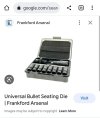I'll disagree with this slightly. While it may be that some can have success with this which will show up on target, its very likely to actually cause worse results.If you want exact CBTO, here is what you can do. Back your seating die off by .003". Seat the bullet, measure CBTO, adjust your die however much you need, reseat and remeasure. Then back it back off and repeat. Much easier with a micrometer seater, but can be done with a standard seater too. I usually strive for CBTO within .0005" of target. Meaning no more than .001" variation.
Virgin brass seems to show far more variation, even with an expanding mandrel process. Properly sized fired brass is usually much better.
The reason is the velocity of the seating op has a bearing on the bullets ability to overcome the friction differential between the bullet and neck. Once it comes to a stop, it will take considerably more force to get it moving again. This will result in non-uniform ogive deformation in most instances with standard bullets. This will be difficult to "measure" as comparators do not genuinely generally hit exactly where the seating stem does, and its the alteration of the shape that has the lasting effect, rather than only the distance to datum. It will also result in non-uniform surface interaction at the bullet/neck interface.
This same thing is true of seating primers, but the deformation is significantly more severe on primers and has a much larger impact on target.
However, if you change your recommendation from 3 thousandths, to say, 30 thousandths. Its much more likely to yield positive results. There is enough movement to break the static lock, and get the bullet to achieve some momentum again. If the first seating op was super uniform, then the second one can be more uniform as well if it's moving some reasonable distance.
Though it is noteworthy that doing something twice, will almost universally introduce more variance than doing something once. The only time this would possibly be minimized is if bullet seating is done with automation, such as an AMP press.
It's not just the seating depth uniformity that is important here, but the seating force uniformity as well as component deformation uniformity.
-----------
Follow on Instagram
Subscribe on YouTube
Amazon Affiliate

Last edited:


